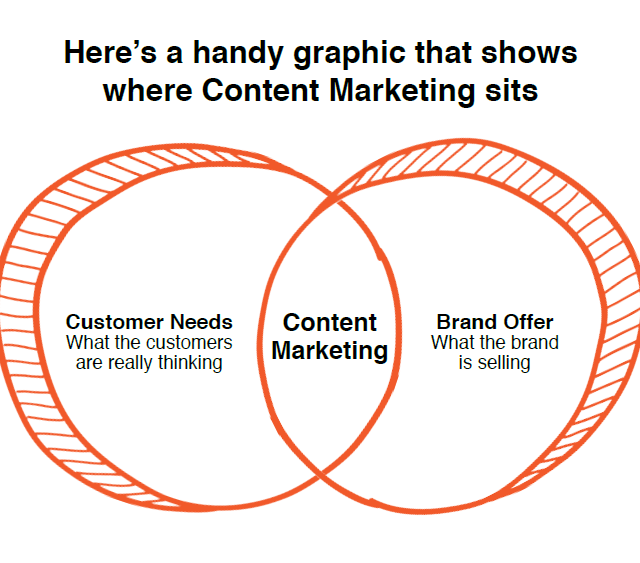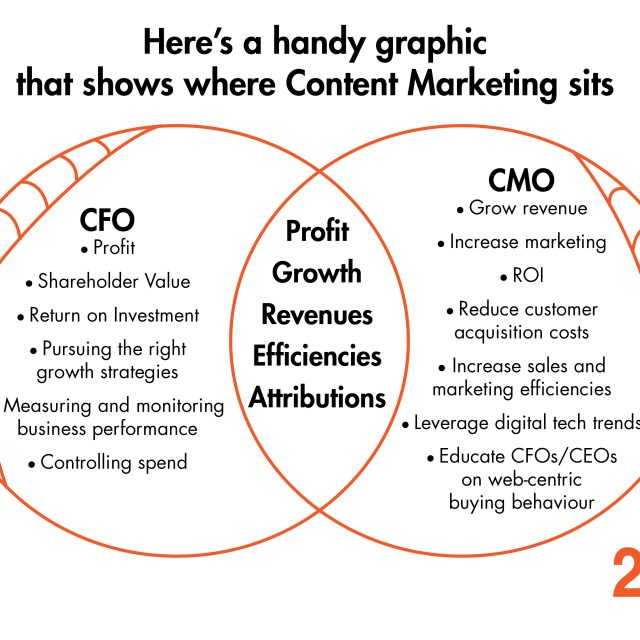How to make your CFO go weak at the knees (and approve increased content marketing spend)

Posted by 256
July 20th, 2015
So you’ve been reading some of the oodles of stuff that’s out there about content marketing – what it is, why it works and all that – and you’re sold. You have come to realise that this is what your organisation should be investing in. Now, all you have to do is go and get the content marketing spend approved.
This can be tricky, because, let’s face it, your CFO and CEO may not have been devouring content about content (content-ception) in the way that you have. So here are some tips as to how to best go about that. In fact, to really spin it on its head, we are going to use a content marketing perspective to explain the best approach.
This is a handy graphic that shows where content marketing sits. In this instance, you are the brand, and what you are selling is the budget switch towards content marketing.

In the left circle sits your CFO, alone with his or her thoughts, which don’t greatly involve content marketing. As you can see, content marketing is about finding the common ground that links what your prospect (CFO) is thinking with your brand offer (budget switch/increase).
Walk a mile in her shoes
As marketers, we can get sucked into our own world and tend to express things in our own language. So it’s a good idea to get close to your CFO, show genuine interest in what issues she is up against at any given moment and pay attention to what she says. You both share similar pressures – you both have profit and growth objectives for the company, with a finite budget. By getting close to her, you can learn what her hot buttons are.
CFOs are generally thinking about
- Profit
- Shareholder value
- Return on investment
- Following the right growth strategies
- Measuring and monitoring performance
- Controlling spending – doing more with less
CFOs are all about the data and measuring results. They are looking for marketing to add to the company’s bottom line in an easily attributable, predictable and efficient way. Which is precisely why PPC advertising makes sense to them and is an easy activity to approve spend on.
Here’s your common ground:

Speak your CFO’s language – here’s how
When talking to your CFO, speak their language, not your own.
Here are 3 tips for doing this:
1) Explain marketing concepts in financial language
2) Talk about high level strategies, not marketing tactics
3) Understand and be comfortable discussing the high level goals and metrics you share (such as LTV, CAC, MQLs/month and ROI)
In other words, do not use terms like brand awareness, impressions, followers and likes. Especially not ‘likes’. When you use terms like that she can’t translate them into revenue, profit and growth.
You will be talking her language when you identify and track metrics that directly relate to profits and revenue. No attribution means lots of pursing of financial lips. Not good.
But this is why content marketing fits nicely into her language.
Here are some ways to describe content marketing that use familiar financial terminology that will sing to her:
Content marketing = Assets
A building, a machine, a blog post. There’s nothing a CFO loves more than an asset. The pieces that you create are assets that are owned by the company and continue to produce over time. As are the workflows and processes that you create to go with those content pieces. A content marketing strategy produces assets that have a compounding effect because they continue to generate value (in the form of leads) over time without additional investment.
(Memorise this and say it to her. She may go a little weak at the knees.)
Content Marketing delivers a compounding return
Compound interest is interest that is added to the principal of a deposit so that the added interest also earns interest.
Here’s a sample of how to explain to her how content marketing works:
‘As we continue to do content marketing month after month, it’s like making deposits to different savings accounts. The savings accounts are held by Google’s search engine and various social media networks. Our deposits are the assets we create and publish (blogs, social posts, ebooks, etc.). These deposits constantly earn interest, in the form of higher positions on search engines and growing social media networks that share our assets. They provide us with income in the form of traffic to our site and leads that we nurture until they are ready to be handed on to sales.
Collectively, these assets deliver a lasting return at no additional cost.
(At this point, she is starting to see you in a completely different light.)
Cost per Lead (CPL)
CPL is how much you spend to acquire one lead. This is found by dividing your marketing costs over a given period by how many leads you generated in that period. This can also be done for individual campaigns, or indeed individual assets. The more granular in terms of assets or campaigns you go the quicker you can see what is working. Tracking CPL will enable you to see how you can continuously improve for efficiency.
CPL can also show you which assets are best for converting leads at each stage of the sales funnel.
Customer Acquisition Cost (CAC)
CAC is the total sales and marketing cost divided by the number of sales acquired over a specified time period.
So if you spent €10,000 in a month on sales and marketing and added 20 customers in that month, then your CAC for that month is €500.
But you should also calculate marketing CAC (M-CAC), which will isolate marketing’s percentage of CAC. So if €4,000 of that total €10,000 spent on sales and marketing, then your M-CAC is €4,000 divided by the 20 customers or €200. Over time, as your content marketing efforts deliver more qualified leads to sales, you will see your M-CAC fall and can show your CFO how much more efficient your content marketing is than traditional marketing.
Lifetime Value
Lifetime value is the average revenue generated by a customer over the entire span of their relationship with your company. It will differ a little from company to company in terms of how it is calculated but your company should have a way to do this. If your company isn’t doing this currently, we suggest you sidle up to the CFO and have a chat about getting it done.
Essentially, it is the average value of a sale x average number of repeat sales x average customer duration.
The value of creating this number is that it provides the context for how much your CAC should be.
Return on Investment (ROI)
This is the profit delivered by the investment you make. Naturally, your CFO wants this figure to be as high as possible, as do you. With content marketing, as with almost all marketing activity, this will not happen instantaneously, but you should start to see some results after about six months.
PPC is one investment that sees an immediate return. You pays your money and you sees your return, but only for as long as you continues to pay. If you stop spending on PPC, the leads stop immediately.
Content marketing, on the other hand, has a much higher ROI than PPC. Estimates in the Irish market put it at 10-30% higher after about 12 months. However, it takes a bit of time to build a lead generation factory that delivers that. Thing is, your firm will own the factory, not be renting it. CFOs hate renting assets because they don’t produce long-term value (an eyebrow may even flutter after you point this out).
Consider the firm that decides to sell out to a buyer. If it has just relied on PPC, it will achieve a lower price than if it has built up a lead generation factory. Because that lead generation factory will continue to produce traffic and leads long after those assets were created (oh, lordy).
What level of ROI can be expected?
Ah, the moment of truth. Here we go. We're going in.
In 2015, an MIT Sloan MBA student completed a research study of the ROI of those companies that were using Hubspot, an inbound marketing software system. Use of such a system isn’t essential, but it does provide a means to easier management of the content marketing process. We liken inbound to being the engine, whereas content is the fuel (256 Media is a Hubspot partner, so contact us if you’d like to know more about how this works).
What Hubspot delivers, however, is a group of 13,500 content marketers that can be easily studied. These are the highlights:
3.15x more visitors per month within one year
4.77x more leads per month within one year
72% of customers saw an increase in sales revenue within one year
Of course, that doesn’t necessarily translate into return on investment. You need to factor in the cost of production and the conversion rate on those new leads. But at least you have a frame of reference to work from now.
You can even use the Hubspot ROI calculator to project the average results for traffic, leads and customers you can expect based on the 13,500 customers that use Hubspot (note that the numbers produced are for example only and should not be used literally).
At this point, who knows what might happen? But that tear in her eye probably isn't from a sudden gust of wind, you smooth-talking divil. Board meetings will never be the same again.
If you'd like some help with making yourself appear more attractive to your CFO or CEO, then please do get in touch. Meantime, you may find this free digital marketing monthly reporting template to be very useful. She'll like you for this one, too. :)
Yo can also request a free Inbound Marketing Consultation with one of our inbound experts and make sure you're getting the most out of your content!

Previous Post
Team Periscope: Having the chats with Scoper Bec Boop
Next Post

How to use GIFs in your digital marketing strategy
Subscribe Here
You may also like...
Nadia Reckmann | Aug 16, 2024
Nadia Reckmann | May 30, 2024
Nadia Reckmann | Nov 23, 2023





